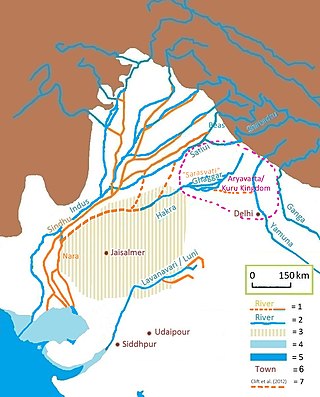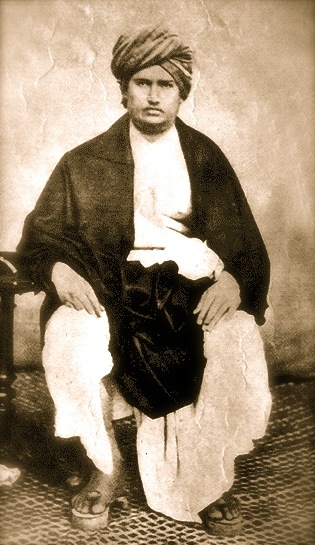Related Research Articles

The Sarasvati River is a deified river first mentioned in the Rigveda and later in Vedic and post-Vedic texts. It played an important role in the Vedic religion, appearing in all but the fourth book of the Rigveda.

Dayanand Saraswati, was an Indian philosopher, social leader and founder of the Arya Samaj, a reform movement of Hinduism. His magnum opus is the book Satyarth Prakash, which has remained a highly influential text on the philosophy of the Vedas and clarifications of various ideas and duties of human beings. He was the first to give the call for Swaraj as "India for Indians" in 1876, a call later taken up by Lokmanya Tilak. Denouncing the idolatry and ritualistic worship, he worked towards reviving Vedic ideologies. Subsequently, the philosopher and President of India, S. Radhakrishnan, called him one of the "makers of Modern India", as did Sri Aurobindo.

Bhrigu was a rishi in Hinduism. He was one of the seven great sages, the Saptarshis, one of the many Prajapatis created by Brahma. The first compiler of predictive astrology, and also the author of Bhrigu Samhita, the astrological (Jyotish) classic, Bhrigu is considered a Manasa Putra ("mind-born-son") of Brahma. The adjectival form of the name, Bhargava, is used to refer to the descendants and the school of Bhrigu. According to Manusmriti, Bhrigu was a compatriot of and lived during the time of Manu, the Hindu progenitor of humanity. Bhrigu had his Ashram (Hermitage) on the Vadhusar River, a tributary of the Drishadwati River near Dhosi Hill in the Vedic state of Brahmavarta, presently on the border of Haryana and Rajasthan in India. Along with Manu, Bhrigu had made important contributions to Manusmriti, which was constituted out of a sermon to a congregation of saints in the state of Brahmavarta, after the great floods in this area. As per Skanda Purana, Bhrigu migrated to Bhrigukutch, modern Bharuch on the banks of the Narmada river in Gujarat, leaving his son Chyavana at Dhosi Hill.

Saraswati is the Hindu goddess of knowledge, music, art, speech, wisdom, and learning. She is one of the Tridevi, along with the goddesses Lakshmi and Parvati.
Rajarshi is a title in Hinduism and Hindu mythology, referring to a sage who hails from a royal background.
Vena is a king in Hinduism, notorious for his wickedness and misrule. A descendant of the first Manu, he bans all worship, offerings, and sacrifices upon his accession. After denying all petitions to restore these practices, Vena is slain by sages with their consecrated blades of grass. He is succeeded by the legendary king Prithu, who springs from his right arm.
Samudra is a Sanskrit term literally meaning the "gathering together of waters". It refers to an ocean, sea or confluence. It also forms the name of Samudradeva, the Hindu god of the ocean. The word is also present on other languages influenced by Sanskrit.

Kalibangān is a town located at 29.47°N 74.13°E on the left or southern banks of the Ghaggar in Tehsil Pilibangān, between Suratgarh and Hanumangarh in Hanumangarh District, Rajasthan, India 205 km. from Bikaner. It is also identified as being established in the triangle of land at the confluence of Drishadvati and Sarasvati Rivers. The prehistoric and pre-Mauryan character of Indus Valley civilization was first identified by Luigi Tessitori at this site. Kalibangan's excavation report was published in its entirety in 2003 by the Archaeological Survey of India, 34 years after the completion of excavations. The report concluded that Kalibangan was a major provincial capital of the Indus Valley Civilization. Kalibangan is distinguished by its unique fire altars and "world's earliest attested ploughed field". It is around 2900 BC that the region of Kalibangan developed into what can be considered a planned city.

Matsya was an ancient Indo-Aryan tribe of central South Asia whose existence is attested during the Iron Age. The members of the Matsya tribe were called the Mātsyeyas and were organised into a kingdom called the Matsya kingdom.

The Drishadvati river is a river hypothesized by Indologists to identify the route of the Vedic river Saraswati and the state of Brahmavarta. According to Manusmriti, the Brahmavarta, where the Rishis composed the Vedas and other Sanskrit texts of the Vedic religion, was at the confluence of the Saraswati and Drishadvati rivers during the Vedic period.
Rigvedic deities are deities mentioned in the sacred texts of Rigveda, the principal text of the historical Vedic religion of the Vedic period.

Siddhpur, also spelled Sidhpur, is a town, municipality and headquarter of Sidhpur taluka in Patan district, in the Indian state of Gujarat. It is a historical place located on the bank of the endorheic Saraswati River, which is probably a remaining of the ancient Sarasvati River.

Vaishampayana is the traditional narrator of the Mahabharata, one of the two major Sanskrit epics of India.

The Kumaras are four sages (rishis) from the Puranic texts of Hinduism who roam the universe as children, generally named Sanaka, Sanandana, Sanatana, and Sanatkumara. They are described as the first mind-born creations and sons of the creator-god Brahma. Born from Brahma's mind, the four Kumaras undertook lifelong vows of celibacy (brahmacharya) against the wishes of their father. They are said to wander throughout the materialistic and spiritualistic universe without any desire but with the purpose of teaching. All four brothers studied Vedas from their childhood, and always travelled together.

Prithu is a sovereign (chakravarti), featured in the Puranas. According to Hinduism, he is an avatar (incarnation) of the preserver god—Vishnu. He is also called Prithu, Prithi and Prithvi Vainya, literally, "Prithu — the son of Vena". Prithu is "celebrated as the first consecrated king, from whom the earth received her (Sanskrit) name, Prithvi." He is mainly associated with the legend of his chasing the earth goddess, Prithvi, who fled in the form of a cow and eventually agreed to yield her milk as the world's grain and vegetation. The epic Mahabharata, Vishnu Purana, and the Bhagavata Purana describe him as a part-avatar (incarnation) of Vishnu.

Shri Gaudapadacharya Math, also known as Kavaḷē maṭha, located in Kavale, Ponda, Goa, is the oldest matha of the Smarthan Saraswat Brahman Samaj. It was founded by Gauḍapāda around 740 AD, whose student was Govinda Bhagavatpada, the guru of Adi Shankara, a highly influential figure in Hinduism. There is also a belief that Gauḍapāda himself established the Shri Gaudapadacharya matha when he lived in Gomantak (Goa). Thus, the matha came to be known as Shri Saunstan Gaudapadacharya matha. Unlike other mathas, Shri Gaudapadacharya matha is not a polemical center established to influence the faith of all Hindus, its jurisdiction is limited to only Dakshinatya Saraswat Brahmins. The Peetadhipathi "head monk" is Śrī Gauḍapadācārya. Smartist Goud Saraswat Brahman Samaj and Rajapur Saraswat Brahmin are its main disciples.

Swami Nigamananda Paramahansa was an Indian yogi, guru and mystic well known in Eastern India. He is associated with the Shakta tradition and viewed as a perfect spiritual master of vedanta, tantra, yoga and prema or bhakti. His followers idealized him as their worshipped and beloved thakura.
Dhi is a Sanskrit word meaning 'understanding', 'reflection', 'religious thought', 'mind', 'design', 'intelligence', 'opinion', 'meditation', 'imagination', 'notion', and 'intellect'. This word is directly connected with the word Vāc, meaning Speech, derived from Vac meaning, 'to speak'. Dhi is the voiced Vāc or 'Speech', it is the thought-mind or intellect. Dhi also means 'to hold' or 'to place', and indicates the activity of the intellect.
Adi Badri, also Sri Sarasvati Udgam Tirath, is a tourist site of archaeological, religious and ecological significance in a forest area in the foothills of the Sivalik Hills in Bhabar area, situated in northern part of Yamunanagar district, of the north Indian state of Haryana. There are remains of many Buddhist stupas and monasteries, which are about 1500–2000 years old, and there is also a group of Hindu temples from the 9th century. Based on the multiple archaeological excavations undertaken here, archaeologists have sent the proposal to Archaeological Survey of India (ASI) to include this site in the list of protected heritage site. Several popular annual festivals are held here, including the five day long National Saraswati Festival in January, Adi Badri Akha Teej Mela in Vaisakh around April–May, week-long Adi Badri-Kapal Mochan Kartik Purnima religious mela around November.

In Hinduism, rivers are often personified as deities. In the Rigveda, there are mentions of holy rivers such as the Sarasvati. The river Ganges is considered to be most sacred, and is personified as the goddess Ganga. Most of the rivers are represented in female form, with the notable exception of Brahmaputra, which is considered to be male. Historically, it is believed that the people of the Indus Valley civilisation worshipped the rivers. The most significant rivers in the faith are the Saptanadi: the Ganges, Yamuna, Sindhu, Narmada, Godavari, Krishna, and Kaveri.
References
- ↑ Mhb 1.90.26
- ↑ "Archived copy". Archived from the original on 2010-11-07. Retrieved 2010-11-07.
{{cite web}}: CS1 maint: archived copy as title (link); sanskrit verse 1.90.25-26 - ↑ http://www.sacred-texts.com/hin/m01/m01096.htm; English translation,page-203,1st paragraph
- ↑ Lal, BB (2002). "The Homeland of Indo-European Languages and Culture: Some Thoughts". Puratattva. Indian Archaeological Society. pp. 1–5.
- ↑ http://asi.nic.in/asi_exca_imp_rajasthan.asp; First paragraph
- ↑ Lal, BB (1984). Frontiers of the Indus civilization. Sir Mortimer Wheeler commemoration volume. pp. 57–58.
- ↑ http://asi.nic.in/asi_exca_imp_rajasthan.asp; Last paragraph
- ↑ http://www.archaeologyonline.net/artifacts/harappa-mohenjodaro.html; Second last paragraph
- ↑ http://www.zeenews.com/Elections08/rajesthanStory.aspx?aid=482985; history,1st paragraph
- ↑ Lal, BB (1984). Frontiers of the Indus civilization. Sir Mortimer Wheeler commemoration volume. pp. 57–58.
- ↑ http://asi.nic.in/asi_exca_imp_rajasthan.asp; Last paragraph
- ↑ Lal, BB (1984). Frontiers of the Indus civilization. Sir Mortimer Wheeler commemoration volume. pp. 57–58.
- Mahabharata of Krishna Dwaipayana Vyasa, translated to English by Kisari Mohan Ganguli